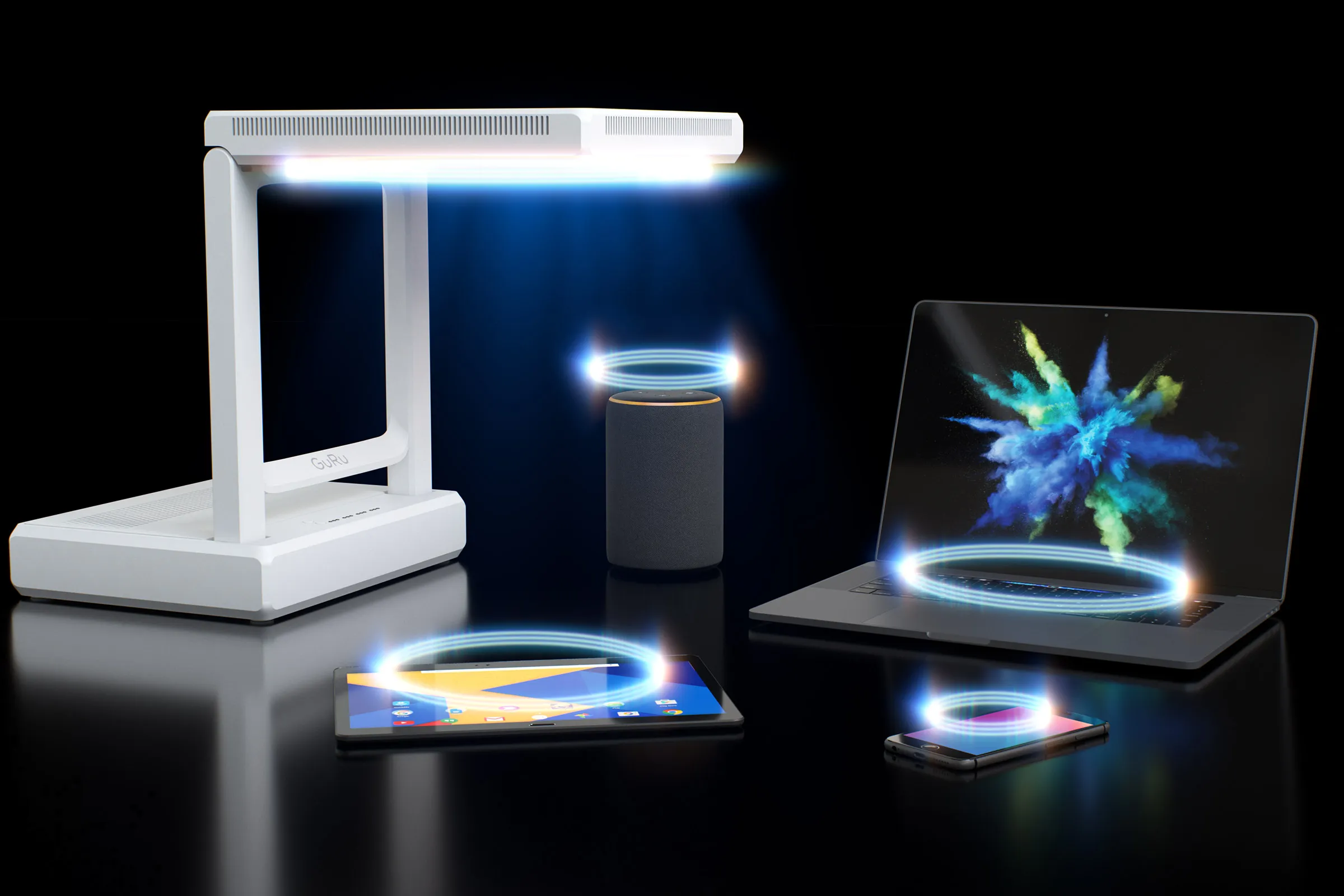Imagine if the smartphone in your pocket, gamepad in your hand, or watch on your wrist could charge wirelessly. No cables, no wireless charging pads. Just wireless power beamed through the air by a router, much like Wi-Fi. The potential benefits for medical devices, sensors, cameras, and a host of other battery-powered gadgets are easy to grasp. Wires and cables are awkward, and batteries are expensive to produce and difficult to recycle.
I first saw wireless power, also known as distance wireless charging, in action seven years ago and was amazed. A small transmitter panel wirelessly powered a light bulb up to 30 feet away across the room. Since then, I’ve seen similar technology powering everything from E Ink displays to earbuds and smartphones. But working prototypes and reference products are one thing. It’s been more than a century since Nikola Tesla proved wireless power over distance was possible, wowing crowds by demonstrating a large transmitter coil powering distant incandescent electric lamps. Implementing that technology in consumer products we can buy is a whole different ball game.
After taking a backseat for years, the technology made a bit of a resurgence in 2021 and at the CES 2022 technology trade show. There’s progress, but you still shouldn’t expect distance wireless charging in many of your household goods anytime soon.
Signs of Progress
Last year, Motorola showed off a smartphone charging wirelessly up to 10 feet away from a transmitter and four smartphones charging simultaneously at closer range. Xiaomi and Oppo teased similar technologies. This year, Samsung’s Eco TV Remote made our Best of CES 2022 short list. Its predecessor relied on solar energy, but the new model adds radio-frequency (RF) harvesting. It grabs the radio waves bouncing around your home, emitted by devices like your Wi-Fi router, and converts them to energy.
Developed by Samsung’s research and development division, this technology was refined by the TV group as a part of a companywide drive to be more environmentally friendly. Instead of a battery inside the remote, there’s a super-capacitor that charges up to 80 percent capacity in just 10 minutes by combining solar and RF harvesting.
This innovation is clever and exciting, but it works only for small devices that don’t require much power. That’s why many players in this space target gadgets like E Ink displays for supermarket shelves, wearables, and internet-of-things (IoT) sensors. Most devices need considerably more power than a TV remote, making a dedicated transmitter (that’s not your Wi-Fi router) essential.
“The key behind our Cota wireless power technology is that we can power devices at distance, control the power, and prioritize which devices get it, but we can also power devices in motion,” says Hatem Zeine, founder, president, and chief technology officer at Ossia, one of the most prominent names in distance wireless charging.
Ossia announced a partnership with tablet maker Archos at CES 2022, showing off concepts for distance charging a smartwatch, camera, and SOS button to help care for the elderly. The idea is that wireless power can keep these monitoring devices charged to track the wearer 24/7. Ossia also unveiled the Cota table, powered wirelessly by a Cota panel on the ceiling, with Qi wireless charging pads and a battery inside (it can also host USB ports). The table is aimed at cafés and venues where running cables is tricky and the flexibility to change seating setups is prized.
The Cota system delivers a few watts of power at close range but drops down to milliwatts with distance and stops being meaningful at around 30 feet. Efficiency is a thorny issue, as there’s a large discrepancy between the power you spend and the power you recover. There are three parts to this: converting power from the outlet to RF, transmitting and receiving RF waves, and converting RF to direct current in the receiving device. Several variables make it tough to arrive at definitive figures, but for the percentage of power recovered, we’re talking about efficiencies in single digits up to high teens at best.
“One AAA battery may cost 50 cents and provide you with one watt-hour of energy,” Zeine is quick to counter. “If you buy power from the wall socket, you’re buying one kilowatt-hour of energy for 10 cents, so a battery is 5,000 times more expensive.”
It’s a strong argument. The price of lithium is soaring because of battery demand. To realize the promise of IoT, we need an alternative to batteries, and wireless power could conceivably be it.
Safety and Certification
All these technologies have a handshake process between the transmitter and receiver that cuts off the radio frequency beam if an obstacle—like a person—gets in the way. Companies are required to jump through hoops for Federal Communications Commission certification to prove their technology is safe, but this is granted on a per-device basis following practical tests conducted by an independent third party (one reason why research moves at a very slow pace). The lack of a common standard is another stumbling block. Consider how long it took for the Qi standard to win out and become ubiquitous in the closer contact wireless charging scene.
But a decade on, Ossia has little to show beyond concepts. After I asked where its technology is in use today, Zeine tells me that Walmart is piloting Cota in distribution centers for inventory tracking and asset management. Toyota is testing its viability to replace wiring in cars, where it could power sensors and make replacing them easier. The partnership with Spigen (announced at CES 2019) to develop wireless charging phone cases has yet to bear fruit.
